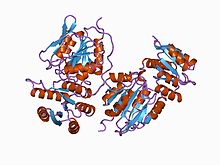- Protein-glutamate methylesterase
-
protein-glutamate methylesterase Identifiers EC number 3.1.1.61 CAS number 93792-01-9 Databases IntEnz IntEnz view BRENDA BRENDA entry ExPASy NiceZyme view KEGG KEGG entry MetaCyc metabolic pathway PRIAM profile PDB structures RCSB PDB PDBe PDBsum Gene Ontology AmiGO / EGO Search PMC articles PubMed articles CheB_methylest 
structural basis for methylesterase cheb regulation by a phosphorylation-activated domain Identifiers Symbol CheB_methylest Pfam PF01339 InterPro IPR000673 SCOP 1chd Available protein structures: Pfam structures PDB RCSB PDB; PDBe PDBsum structure summary In enzymology, a protein-glutamate methylesterase (EC 3.1.1.61) is an enzyme that catalyzes the chemical reaction
- protein L-glutamate O5-methyl ester + H2O
 protein L-glutamate + methanol
protein L-glutamate + methanol
Thus, the two substrates of this enzyme are protein L-glutamate O5-methyl ester and H2O, whereas its two products are protein L-glutamate and methanol.
This enzyme is a demethylase, and more specifically it belongs to the family of hydrolases, specifically those acting on carboxylic ester bonds. The systematic name of this enzyme class is protein-L-glutamate-O5-methyl-ester acylhydrolase. Other names in common use include chemotaxis-specific methylesterase, methyl-accepting chemotaxis protein methyl-esterase, CheB methylesterase, methylesterase CheB, protein methyl-esterase, protein carboxyl methylesterase, PME, protein methylesterase, and protein-L-glutamate-5-O-methyl-ester acylhydrolase. This enzyme participates in 3 metabolic pathways: two-component system - general, bacterial chemotaxis - general, and bacterial chemotaxis - organism-specific.
CheB is part of a two-component signal transduction system. These systems enable bacteria to sense, respond, and adapt to a wide range of environments, stressors, and growth conditions.[1] Two-component systems are composed of a sensor histidine kinase (HK) and its cognate response regulator (RR).[2] The HK catalyses its own auto-phosphorylation followed by the transfer of the phosphoryl group to the receiver domain on RR; phosphorylation of the RR usually activates an attached output domain, in this case a methyltransferase domain.
CheB is involved in chemotaxis. CheB methylesterase is responsible for removing the methyl group from the gamma-glutamyl methyl ester residues in the methyl-accepting chemotaxis proteins (MCP). CheB is regulated through phosphorylation by CheA. The N-terminal region of the protein is similar to that of other regulatory components of sensory transduction systems.
Structural studies
As of late 2007, two structures have been solved for this class of enzymes, with PDB accession codes 1A2O and 1CHD.
References
- ^ Skerker JM, Prasol MS, Perchuk BS, Biondi EG, Laub MT (October 2005). "Two-component signal transduction pathways regulating growth and cell cycle progression in a bacterium: a system-level analysis". PLoS Biol. 3 (10): e334. doi:10.1371/journal.pbio.0030334. PMC 1233412. PMID 16176121. http://www.pubmedcentral.nih.gov/articlerender.fcgi?tool=pmcentrez&artid=1233412.
- ^ Stock AM, Robinson VL, Goudreau PN (2000). "Two-component signal transduction". Annu. Rev. Biochem. 69: 183–215. doi:10.1146/annurev.biochem.69.1.183. PMID 10966457.
Further reading
- Kehry MR, Doak TG, Dahlquist FW (1984). "Stimulus-induced changes in methylesterase activity during chemotaxis in Escherichia coli". J. Biol. Chem. 259 (19): 11828–35. PMID 6384215.
This article includes text from the public domain Pfam and InterPro IPR000673

This hydrolase article is a stub. You can help Wikipedia by expanding it. - protein L-glutamate O5-methyl ester + H2O
